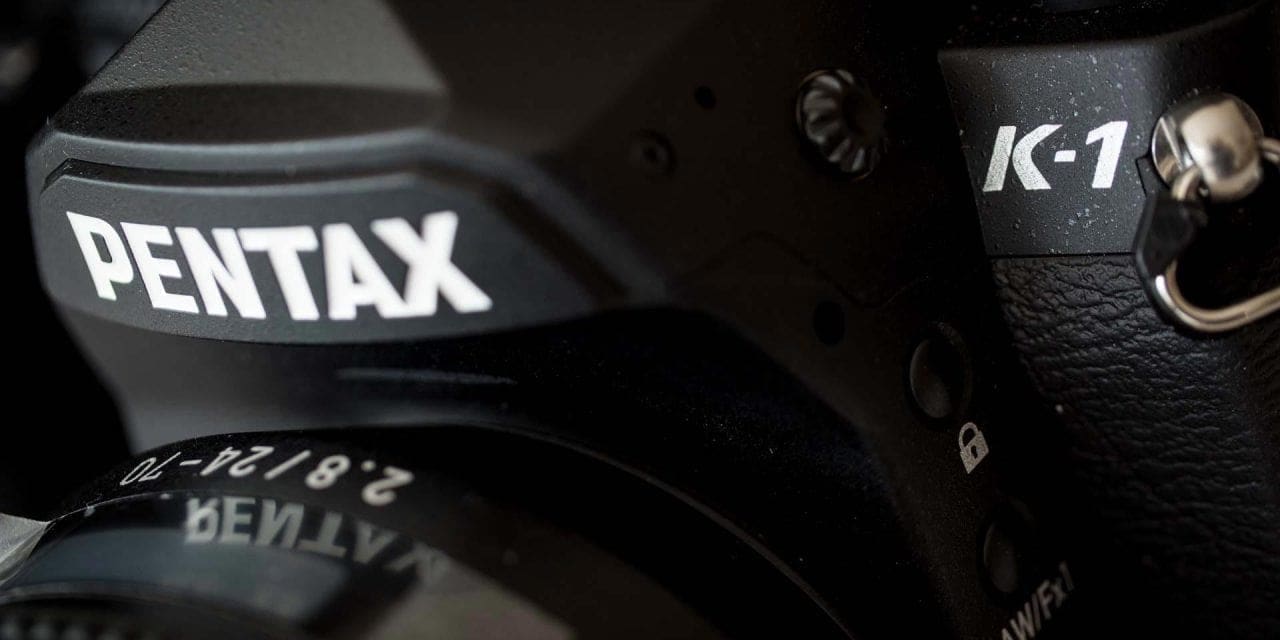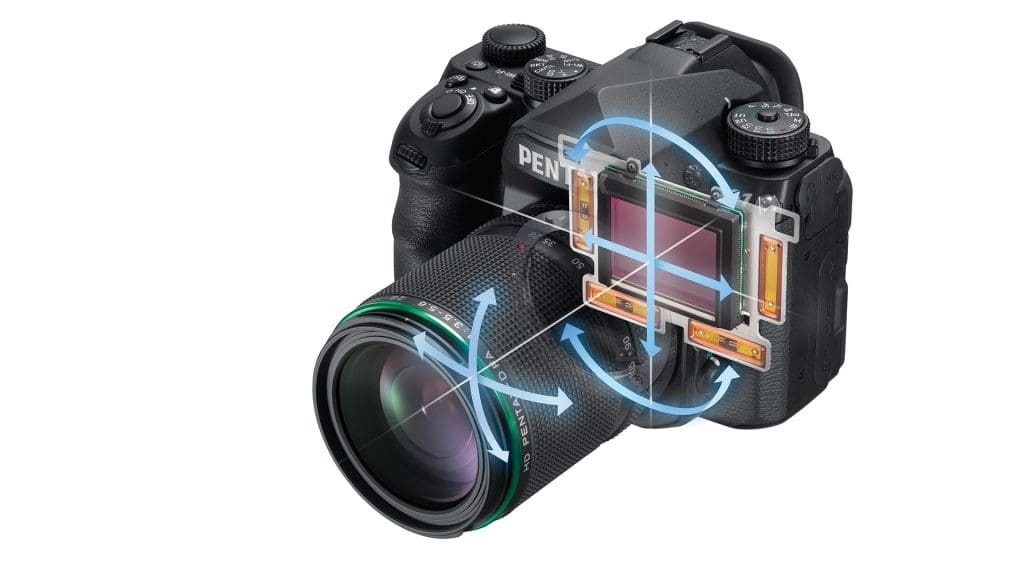Pentax K-1 30 second review…
The Pentax K-1 is a 36Mp full-frame DSLR with a few clever features such as the ability to track stars in the sky for blur-free shots and a resolution boosting system that can even be used when the camera is hand-held. In addition there’s a very effective stabilisation system that helps maintain the camera’s high detail resolution when shooting hand-held.
The main attraction of the K-1 is that it offers a relatively affordable route to full-frame photography, a weather-proof body and lens compatibility going back to 1975. It’s autofocus system is a bit sluggish and the maximum shooting rate is just 4.4fps so it’s better suited to shooting landscape than sports.
Key features
| Camera Name | Pentax K-1 |
| Camera type | DSLR |
| Date announced | 17th Feb 2016 |
| Price at launch | £1,599/$1,797 |
| Sensor size | Full-frame (35.9 x 24mm) |
| Effective pixel count | 36.4 million |
| Processor | PRIME IV |
| Lens/Mount | KAF2 |
| Viewfinder | Optical with pentaprism 100% coverage |
| Sensitivity range | ISO 100-240,800 |
| Reflex AF system | 33-point with 25 cross-type |
| Live View AF system | Contrast detection |
| Monitor | 3.2-inch TFT LCD with 1,037,000 dots |
| Max shooting rate | 4.4fps |
| Max video resolution | Full HD (1920×1080) |
| Storage | 2x SD/SDHC/SDXC (UHS-I) |
| Dimensions | 110 x 136.5 x 85.5mm |
| Weight | 925g (body only), 1,010g (with battery & 1 card) |
I’ve been asking Pentax about a full-frame camera ever since the company first started making digital SLRs, but we only got confirmation that one was on the way in February 2015. This was followed by a year of sparse information and dummy models in glass cases before the K-1 was unveiled in February this year (2016).
Inside the K-1 is a Sony 36MP full-frame (35.9 x 24mm) sensor that’s mounted giros for 5-axis stabilisation that claimed to enable an exposure time extension of up to 5 stops.
To boost detail resolution, the sensor lacks an anti-aliasing (AA) filter but Pentax’s AA filter simulation system is resent to reduce moire patterning by making sub-pixel level vibrations if necessary.
Image processing is handled by the 14-bit PRIME IV engine which enables a standard sensitivity range of ISO 100-204,800, maximum continuous shooting rate of 4.4fps (frames per second) and Full HD (1920×1080) video recording at up to 60i or 30p in H.264 format.
There’s also a 33-point SAFOX 12 autofocus system with 25 cross-type points and point selection options including Expanded Area (smaller, medium and large area), Zone select and Auto (33 point) which are designed to help when shooting moving subjects in continuous autofocus mode.
Exposure metering is taken care of by an 86,000-pixel RGB sensor and the Real-TIme Scene Analysis system which monitors brightness and colour.
As usual, the K-1 has Wi-Fi connectivity built-in, but there’s also a GPS unit, a digital compass to record which way the camera is pointing and Pentax’s Astro Tracer system that can be used to control the movement of the imaging sensor during exposures as long as five minutes to produces streak-free images of stars. Pentax has also included its Pixel Shift Resolution system that’s designed to record better colour and definition.
It works by moving the sensor by a pixel width between each of four shots which are then composited into one image. For the first time there are two modes for this.
The first being the one we have seen before that should only be used when camera is on a tripod and with a motionless subject and a second new option that is able to cope with moving subjects and the camera being hand-held. Pentax still recommends using a tripod for the best results though.
Pentax K-1 Build and Handling
Although heavy, the K-1 is exceptionally comfortable to hold because of the well-sculpted front and rear grips and excellent grippy covering.
It’s constructed from magnesium alloy, which makes it feel solid, and there are seals to keep out dust and moisture. Plus Pentax claims it can operate down to -10C.
However, it’s worth noting that the rubber cap over the mic port was prone to lifting when the camera was carried on a strap over my shoulder. This could be a problem in wet conditions.
Thanks to the number of buttons and dials, you can tell just by looking at the K-1 that it’s aimed at experienced photographers. All the controls seem well made and dials require just the right amount of effort to turn.
The top-late has an unusual Smart Function Dial that is helpful for accessing features such as HDR, Bracketing, Shake Reduction, continuous shooting speed, sensitivity, Wi-Fi and APS-C format Crop. All you do is rotate it to the feature you want then use another nearby dial to adjust the setting.
I tended to leave it set to sensitivity for quick and easy adjustments, but you can change to another option in a flash. One quirk, which could be resolved with a firmware upgrade is that after using these dials to activate auto exposure bracketing is that you can’t use them to deactivate it, you have to access the drive mode options via the Up navigation key.
One disappointment with the K-1 is that Pentax hasn’t taken the opportunity to introduce a more modern looking menu, it looks very dated. That said, all the options you need are present.
In addition to the main menu and the Status screen, there’s a secondary information screen that’s activated by pressing the Info button and gives access to 20 features for adjustment. The icons are small and some are hard to distinguish, making it hard to go straight to the one you want in the ‘familiarisation’ phase.
The Status screen is essentially a map for the buttons on the back of the camera and is relatively modern looking. It’s especially useful for checking whether the camera is in AF point selection mode or not just before you raise it to your eye to take a photograph.
If it’s not you need to press the button immediately above the navigation pad before you can select the point you need. It’s a routine that you need to get into to avoid changing other camera settings accidentally.
Pentax has given the K-1 a novel articulating mount for its 3.2-inch 1,037,000-dot LCD. Instead of the usual hinge, there are four pivoting spindles that enable the screen to be manipulated into position.
It’s an incredibly tough construction and you can pick the camera up by the screen without fear of damage, but the range of movement is a bit restricted when you’re shooting in portrait orientation. The screen itself gives a nice detailed image.
There’s also an optical viewfinder that uses a pentaprism and provides a 100% view. It’s clear and bright but there’s a very faint texture and a pattern of concentric circles just visible in some areas.
Pentax K-1 Performance
Pentax’s Pixel Shift Resolution technology gives a boost to detail resolution that is just visible in images examined at 100%. The difference is not usually apparent at normal viewing and printing sizes. With a stationary subject and the camera on a tripod, there’s only the slightest difference visible between the results captured with Motion Correction and those without. With a moving subject, however, the differences can be dramatic as without motion correction there rainbow colours over the subject.
The sensor can also be shifted to compensate for accidental camera movements and it works extremely well. With the new 24-70mm lens at the 70mm I was able to get consistently sharp images (at 100%) at shutter speeds as low as 1/5sec.
The K-1 has an advanced autofocus system and I was keen to see how it performed with a moving subject when using the new 24-70mm f/2.8 and 70-20mm f/2.8 lenses. Unfortunately it proved to be a rather frustrating experience because the focusing is just a little too slow for subjects moving beyond a walking pace.
When photographing a dog running towards me, for example, the focus was on the animals body rather than its face despite the central focus point being selected and held in the right position. It also struggled a little when shooting active children. I was able to get sharp images, but not as easily as I would with a Canon 5D Mark III for example.
In live view mode the camera uses contrast detection for focusing, but like similar DSLR systems, it’s a little on the slow and indecisive side. It can’t match-up to the performance of the Canon 80D, which has a phase detection system for live view focusing, nor that of a modern compact system camera like the Olympus OM-D E-M10 Mark II. Anyone shooting video would be well advised to shift focus manually during filming.
Colours are handled well, with colours generally looking natural in the default settings.
Pentax K-1 Verdict
While it may not be the best choice for sports photographers, the Pentax K-1 is a great camera for dedicated landscape, still life, macro and portrait photographers. It’s 36Mp sensor captures a high level of detail, which can be boosted by using the Pixel Shift Resolution system.
Colours are also handled sympathetically, so they look vibrant but natural. The rugged, weather-proof design further enhances its landscape-shooting credentials.
It’s a shame that Pentax hasn’t introduced a more modern looking menu and you need to get into the habit of checking that AF point selection mode is activated, but the comparatively low price for a full-frame DSLR helps smooth over these minor issues.
READ MORE
Best DSLRs in the world in 2016
Best travel cameras you can depend on









